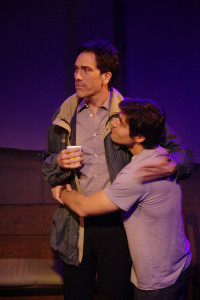On October 6, 1998, a gay University of Wyoming student named Matthew Shepard was savagely beaten, tied to a fence at the edge of town, and left for dead. He was discovered the next day, and clung to life until finally succumbing to his injuries on October 12, 1998. Following the attack and during the subsequent investigation and trial of this heinous hate-crime, Laramie, Wyoming, became the central focus of international media attention. The Tectonic Theatre Project from New York City traveled to Laramie, not to sensationalize the crime, but to talk to the locals and hear their story. What resulted from their visit was the play, “The Laramie Project” chronicling the assault and local reaction in a documentary-esque theatrical production.
In 2008, the Tectonic Theatre Project returned to Laramie to see how the town had changed. How had Laramie constructed their history? For the most part they were shocked by their findings. They found pockets of growth, but little community growth. Fueled in part by a fallacious “20/20” expose, there was widespread belief that the Matthew Shepard killing had not been a hate-crime, but actually a robbery/drug deal gone bad, and that the two assailants had been on a week-long drug induced high when the attack occurred. This perception prevailed despite the original testimony during the trial and the evidence showing that neither assailant was on drugs.
“The Laramie Project Ten Years Later” is an eye-opening account of one community’s desire to own and control their own history. It is a long proven fact that history is written by the ruling class; often the only difference between a hero and a traitor is that the former wound up on the winning side of the war. So it is unfortunately not surprising that Matthew Shepard’s story has changed. There are several poignant interviews and moments that encapsulate this: “We are the state of Matthew Shepard and ‘Broke Back Mountain’ and people resent that,” and “We have a drug problem is easier to accept, than we are hate filled and homophobic.” However, this is not a play condemning the small town of Laramie or Wyoming. There is hope contained within the production and reminders that despite the slow progress there is change being made, it just doesn’t seem like a lot because the expectations were so high: “New York City hasn’t had the type of change expected of Laramie.”
Director Ken Sawyer makes wonderful use of a very small space. The actors sit amongst the audience creating a feel of community as they come and go. With the exception of the actors playing the two assailants, everyone else plays several roles switching from one to the next seamlessly with simple yet distinctive costume pieces, designed by Paula Higgins. This coupled with Sawyer’s fluid, yet simplistic blocking keeps the pace going and the focus on the story being told. There is nothing big or flashy, which makes the piece all the more impactful.
Johanna Chase provides live music throughout the production and bookends the piece with a hauntingly beautiful rendition of “Morning Comes,” originally by Delta Rae. The interview between Aaron McKinney, played by Michael Hanson, and Tectonic company member Greg Pierotti, played by Paul Witten, was uncomfortable in the extreme because of McKinney’s oddly assigned remorse and ho-hum attitude. This contrasted nicely with the soft-spoken, raw performances of Elizabeth Herron as Judy Shepard, Ed F. Martin as Dennis Shepard and Che Landon as Romaine Patterson. This ensemble is of the highest caliber, and their performances combine to tell a story that everyone should hear. This play serves to remind us that even years later, no matter how uncomfortable it may be, the truth should never be forgotten: “It’s no disgrace for Laramie that the crime was labeled homophobic. How we talk about it does disgrace Laramie. Denial is not okay.”
*Coverage provided for the Culver City News

